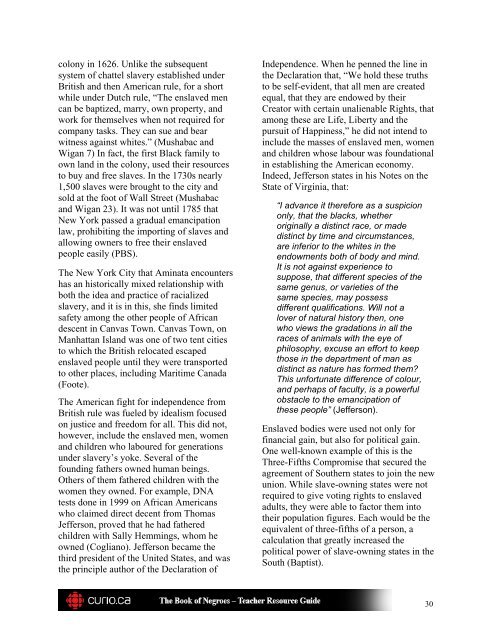ppgl2eq
ppgl2eq
ppgl2eq
Create successful ePaper yourself
Turn your PDF publications into a flip-book with our unique Google optimized e-Paper software.
colony in 1626. Unlike the subsequent<br />
system of chattel slavery established under<br />
British and then American rule, for a short<br />
while under Dutch rule, “The enslaved men<br />
can be baptized, marry, own property, and<br />
work for themselves when not required for<br />
company tasks. They can sue and bear<br />
witness against whites.” (Mushabac and<br />
Wigan 7) In fact, the first Black family to<br />
own land in the colony, used their resources<br />
to buy and free slaves. In the 1730s nearly<br />
1,500 slaves were brought to the city and<br />
sold at the foot of Wall Street (Mushabac<br />
and Wigan 23). It was not until 1785 that<br />
New York passed a gradual emancipation<br />
law, prohibiting the importing of slaves and<br />
allowing owners to free their enslaved<br />
people easily (PBS).<br />
The New York City that Aminata encounters<br />
has an historically mixed relationship with<br />
both the idea and practice of racialized<br />
slavery, and it is in this, she finds limited<br />
safety among the other people of African<br />
descent in Canvas Town. Canvas Town, on<br />
Manhattan Island was one of two tent cities<br />
to which the British relocated escaped<br />
enslaved people until they were transported<br />
to other places, including Maritime Canada<br />
(Foote).<br />
The American fight for independence from<br />
British rule was fueled by idealism focused<br />
on justice and freedom for all. This did not,<br />
however, include the enslaved men, women<br />
and children who laboured for generations<br />
under slavery’s yoke. Several of the<br />
founding fathers owned human beings.<br />
Others of them fathered children with the<br />
women they owned. For example, DNA<br />
tests done in 1999 on African Americans<br />
who claimed direct decent from Thomas<br />
Jefferson, proved that he had fathered<br />
children with Sally Hemmings, whom he<br />
owned (Cogliano). Jefferson became the<br />
third president of the United States, and was<br />
the principle author of the Declaration of<br />
Independence. When he penned the line in<br />
the Declaration that, “We hold these truths<br />
to be self-evident, that all men are created<br />
equal, that they are endowed by their<br />
Creator with certain unalienable Rights, that<br />
among these are Life, Liberty and the<br />
pursuit of Happiness,” he did not intend to<br />
include the masses of enslaved men, women<br />
and children whose labour was foundational<br />
in establishing the American economy.<br />
Indeed, Jefferson states in his Notes on the<br />
State of Virginia, that:<br />
“I advance it therefore as a suspicion<br />
only, that the blacks, whether<br />
originally a distinct race, or made<br />
distinct by time and circumstances,<br />
are inferior to the whites in the<br />
endowments both of body and mind.<br />
It is not against experience to<br />
suppose, that different species of the<br />
same genus, or varieties of the<br />
same species, may possess<br />
different qualifications. Will not a<br />
lover of natural history then, one<br />
who views the gradations in all the<br />
races of animals with the eye of<br />
philosophy, excuse an effort to keep<br />
those in the department of man as<br />
distinct as nature has formed them?<br />
This unfortunate difference of colour,<br />
and perhaps of faculty, is a powerful<br />
obstacle to the emancipation of<br />
these people” (Jefferson).<br />
Enslaved bodies were used not only for<br />
financial gain, but also for political gain.<br />
One well-known example of this is the<br />
Three-Fifths Compromise that secured the<br />
agreement of Southern states to join the new<br />
union. While slave-owning states were not<br />
required to give voting rights to enslaved<br />
adults, they were able to factor them into<br />
their population figures. Each would be the<br />
equivalent of three-fifths of a person, a<br />
calculation that greatly increased the<br />
political power of slave-owning states in the<br />
South (Baptist).<br />
30


